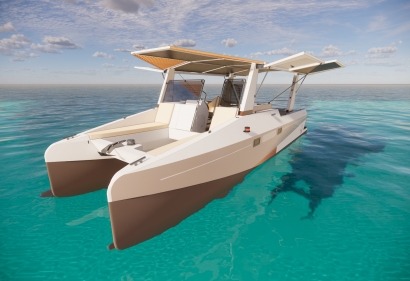
With a length of 9.50m and a beam of 3.40m, the M9 is equipped with 300 kg of photovoltaic panels, ensuring environmentally friendly propulsion. Founder Philippe Raynaud points out that this catamaran, weighing just 2.4T , will be lighter and have a thinner hull. It offers silent, vibration-free sailing, similar to that of a sailing boat.
Thanks to its batteries, it can operate even in the absence of sunlight, including at night. On a typical day's sailing, it has a total range of 8 hours to 20 hours, at a cruising speed of 6 to 9 knots. Its maximum speed reaches 12 knots (20 km/h), more than enough for most yachtsmen sailing close to the coast.
The M9's founder, Philippe Raynaud, originally from the Côte d'Azur and now living in Luxembourg, chose to set up in the west of France to benefit from the naval expertise of Brittany and Normandy. The boat is currently being built at the 'La Passagère' shipyard in Saint-Malo. The launch of the M9 is scheduled for the end of October, followed by trials on the Rance. Official promotion will take place at the 2024 boat shows, before the boat goes on sale. Priced at €250,000, Millikan Boats is aiming to sell ten units a year.
Except for the batteries, which are made in China, the M9 is an entirely French product. The start-up has chosen an English name, Millikan, in reference to the American inventor of photovoltaic cells, Robert Millikan. The decision was prompted by the potential of the Caribbean sailing market.
This innovative catamaran has several remarkable features. Firstly, it is equipped with two-sided solar wings that unfold during sailing, increasing the efficiency of the solar panels by 20%. With a production capacity of 6 kWp, the M9 has a considerable source of energy for a catamaran under 10 metres. What's more, it has a control interface similar to that of a car, which controls all the parameters and enables a virtual anchor, avoiding the need for a real anchor.
Finally, the folded solar wings, combined with glass panels and special canvas, create a 12 m2 enclosed space known as the 'deck cabin'. Inside, there is a coffee table that converts into a bed and a galley. The hulls house two cabins and a bathroom with shower and WC. At the stern, there are two bathing areas.
The M9 has been carefully designed to guarantee virtually unlimited autonomy at a speed of six knots, thanks to the boat's high photovoltaic capacity. Energy efficiency is further enhanced by the choice of a catamaran with narrow hulls to reduce drag, and by the absence of energy-hungry systems such as air conditioning or a generator.
The first M9 is currently under construction and will be completed in the coming months. A second model will also be built and will be available for sale at boat shows next spring.

